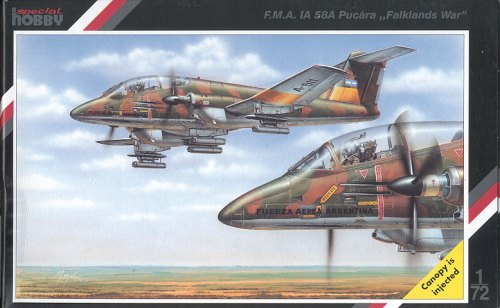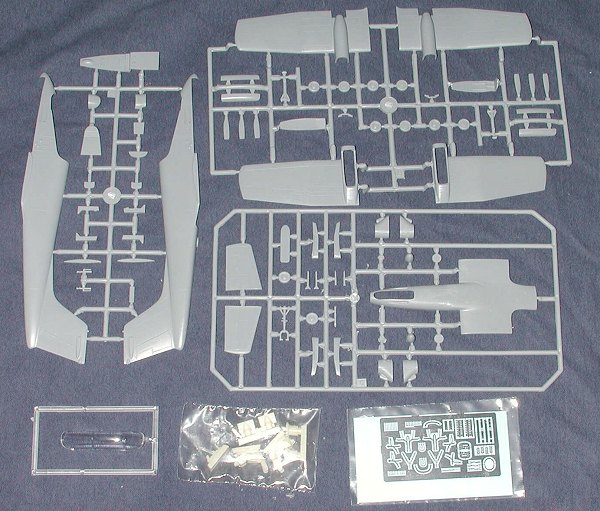
|
KIT: |
Special Hobby 1/72 FMA Pucara |
|
KIT # |
72047 |
|
PRICE: |
$20 (Including its part of air shipment from OZ) |
|
DECALS: |
four options |
|
REVIEWER: |
Scott Van Aken |
|
NOTES: |
Short run with resin and etched metal bits |

|
HISTORY |
Their first actions came soon in 1975 when the first two aircraft were used against Bolivian insurgents. In 1978 all of the Pucaras were then flown to bases in Patagonia to provide support against possible incursions by Chilean forces. Next action was in 1982 in the Falkland Islands when Argentina's new military government invaded these British overseas islands. Due to the lack of prepared facilities, the Pucara was perfect as it was able to operate from unprepared and gravel runways, so a force was sent to provide protection for the invading forces. Unfortunately, the response from Britain was much greater than the leadership had anticipated. The result was a short and rather fierce conflict. Most of the Pucaras were destroyed on the ground by air attacks and British SAS operations. Three were shot down: one by a Sea Harrier, one by a Stinger SAM, and the other by small arms fire. Pucaras used in the Falklands were given various camouflage schemes over their peace-time bare metal finish.
Pucaras have also been used by Colombia, Uruguay and Sri Lanka, the latter using them against Tamil separatists who managed to destroy two of them. Manufacture ceased in 1988, yet there are still three undelivered as of this writing (2003), due to lack of funding. A total of 111 (including prototypes) were built.
|
THE KIT |

Not wanting to sound like a broken record, but this is a kit very typical of what the MPM conglomerate is producing. Well molded with nicely engraved detail. No alignment pins, no flash and the only ejector pins stubs found on the large pieces where they can be easily removed. The kit includes a one piece injected canopy, which on my kit had been cracked during shipment. I've sent a request to Special Hobby for a new one so it will be interesting to see if they will respond by sending a new one.
The kit is a bit unusual in that there is a lower fuselage section that includes a lower wing stub. This will help to properly align the Pucara's wing, which has a very distinct shape. Interestingly, the resin is not as extensive as in some other kits. In this case it is restricted to the seats, the very forward engine, the engine exhaust, and a few antennas. The photo etched fret includes the instrument panels, side console detail, miscellaneous interior detail, seat harnesses, oleo scissors, and landing gear retraction struts. The prop has reverted back to separate blades glued to a tiny hub. Though no indication of how much nose weight is needed, it will require quite a bit and there isn't a lot of space to put it!
![]() The
instructions are quite good and seem to have undergone a bit of a change
as the look of them is different. There are more smaller construction
steps and there is no block delineation of them as in the past. Also
included are some notes on color scattered throughout the build portion
of the instructions. This takes place of a dedicated color chart normally
seen at the beginning of the instructions. Color info is generic with
Humbrol paint numbers. Markings are provided for four aircraft. Two of
them are in the aluminum finish and two are camouflaged in approximately
the same scheme of light brown, light green over light blue as shown on
the box artwork. I'd have thought that the very interesting mottled
scheme of the one Pucara brought back to the UK would have been included
to add a bit of interest. The small decal sheet is well printed and
appears to be quite thin so it should work well.
The
instructions are quite good and seem to have undergone a bit of a change
as the look of them is different. There are more smaller construction
steps and there is no block delineation of them as in the past. Also
included are some notes on color scattered throughout the build portion
of the instructions. This takes place of a dedicated color chart normally
seen at the beginning of the instructions. Color info is generic with
Humbrol paint numbers. Markings are provided for four aircraft. Two of
them are in the aluminum finish and two are camouflaged in approximately
the same scheme of light brown, light green over light blue as shown on
the box artwork. I'd have thought that the very interesting mottled
scheme of the one Pucara brought back to the UK would have been included
to add a bit of interest. The small decal sheet is well printed and
appears to be quite thin so it should work well.
|
CONCLUSIONS |
We finally have a decent injected Pucara in 1/72 and that should make quite a few people happy. Now you can pack up your Rareplanes vac kits or that horrid little Puky kit, which was really more of a toy than a serious model!
Late note: I was sent some scans by an Argentine reader that show the MPM kit to have a nose that is a bit high, a touch narrow in wing chord, a too squared off wing tip, and a fin leading edge that is swept back a bit too much. Anyone confirm this?
If you would like your product reviewed fairly and fairly quickly by a site that has over 200,000 visitors a month, please contact me or see other details in the Note to Contributors.